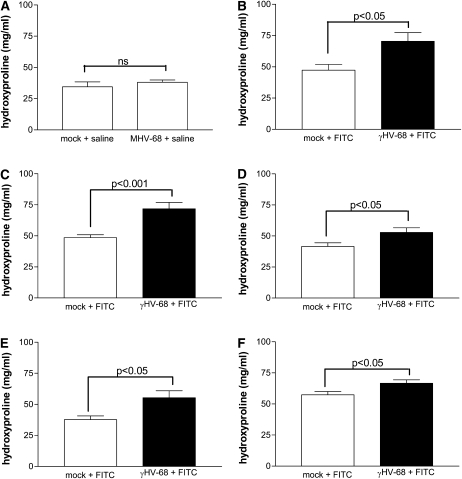Figure 2.
Latent γherpesvirus-68 (γHV-68) augments fluorescein isothiocyanate (FITC)-induced pulmonary fibrosis. (A) Wild-type C57Bl/6 mice were inoculated intranasally with 5 × 104 plaque-forming units of γHV-68 or were mock infected with saline on Day 0. Then, at 14 days post infection (d.p.i.), mice of both groups were administered intratracheal saline. Lungs were harvested 21 days after saline intratracheal administration, which is 35 d.p.i. Hydroxyproline assay of the lungs demonstrates that γHV-68 infection alone does not augment collagen levels in the lung compared with lungs of mock-infected mice, n = 4–5. (B) 14, (C) 21, (D) 30, (E) 45, and (F) 70 d.p.i., γHV-68–infected mice and mock-infected mice were administered intratracheal FITC. In each case, lungs were harvested 21 days after FITC administration. Hydroxyproline assays of the harvested lungs demonstrate that γHV-68 infection before FITC at each time point causes a significant augmentation in collagen levels in fibrotic lungs. For B, C, D, and F data were combined from two to three experiments. The n values for the mock+FITC and γHV-68+FITC groups, respectively, are as follows: B, n = 7, 11; C, n = 14, 12; D, n = 10, 9; F, n = 13, 18. E represents a single experiments with n = 5 mice per group.

